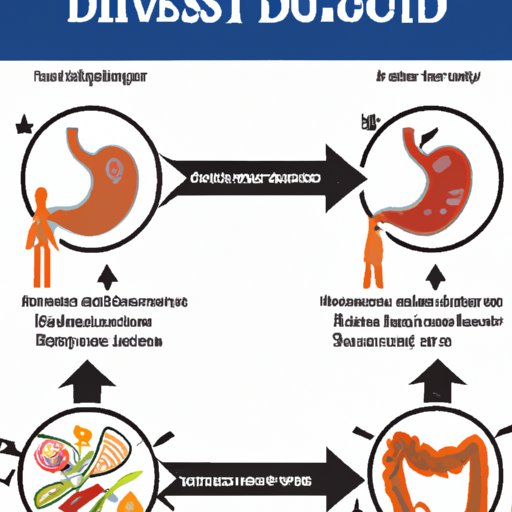Exploring the Digestive System: How Does it Work?
The human body is a complex network of systems that work together to keep us healthy and functioning. One of these systems is the digestive system, which plays an essential role in breaking down food for energy and nutrients. In this article, we will explore how the digestive system works and what role different organs play in the digestion process. We will also look at which foods help and hinder digestion and discuss common digestive issues and treatment options.

Overview of the Digestive System
The digestive system is made up of several organs that work together to break down food into smaller components that can be used by the body. The major organs involved in the digestive process include the mouth, esophagus, stomach, small intestine, large intestine, rectum, and anus. These organs are connected by a series of muscles that contract and relax to move food through the digestive tract.
The Journey of Food Through the Digestive System
The journey of food through the digestive system begins with the mouth. Here, food is chewed and mixed with saliva, which contains enzymes that begin to break down the food. The bolus (chewed food) then moves down the esophagus to the stomach, where further breakdown occurs. From there, the food passes through the small intestine, where most of the digestion and absorption of nutrients takes place. The remaining waste material then travels to the large intestine, where water and other nutrients are absorbed before the waste is eliminated through the rectum and anus.
A Step-by-Step Guide to Understanding the Digestive Process
To better understand the digestive process, let’s take a closer look at the role each organ plays in the digestion of food.

The Role of Different Organs in the Digestion Process
The mouth is the first stop on the digestive journey. Here, food is chewed and mixed with saliva, which contains enzymes that begin to break down the food. From the mouth, the food travels down the esophagus to the stomach, where further breakdown occurs. The stomach produces acids and enzymes that help to further break down the food. From the stomach, the partially digested food passes into the small intestine, where most of the digestion and absorption of nutrients takes place. The small intestine is lined with tiny finger-like projections called villi, which absorb nutrients from the food and pass them into the bloodstream. The remaining waste material then moves to the large intestine, where water and other nutrients are absorbed before the waste is eliminated through the rectum and anus.
The Digestive Process Step-by-Step
The digestive process can be broken down into the following steps:
- Ingestion – Taking in food and liquid
- Propulsion – Moving food and liquid through the digestive system
- Mechanical digestion – Breaking down food into smaller pieces
- Chemical digestion – Breaking down food into even smaller molecules
- Absorption – Taking in nutrients from the digested food
- Elimination – Removing any undigested food and waste material
Foods That Help and Hinder Digestion
Certain foods can help or hinder the digestive process. Let’s take a look at some of the best and worst foods for digestion.
Foods that Aid Digestion
There are many foods that can help support a healthy digestive system. These include high-fiber fruits and vegetables, such as apples, pears, broccoli, and spinach. Whole grains, such as oats and quinoa, are also beneficial, as they provide additional fiber. Probiotic foods, such as yogurt, sauerkraut, kimchi, and kefir, can also help to balance gut bacteria and promote healthy digestion. Finally, healthy fats, such as olive oil, avocados, and nuts, can help to lubricate the digestive tract and make it easier for food to pass through.
Foods that Inhibit Digestion
Some foods can actually hinder digestion. These include processed and refined foods, such as white bread and pasta, which lack fiber and can slow down digestion. Fried and greasy foods can also cause indigestion and heartburn. Alcohol and caffeine can also irritate the digestive tract and lead to inflammation. Finally, dairy products, such as milk and cheese, can be difficult for some people to digest due to lactose intolerance.

Common Disorders of the Digestive System and How to Treat Them
There are many common digestive disorders that can affect the digestive system. These include indigestion, heartburn, irritable bowel syndrome (IBS), constipation, and ulcers. Treatment for these conditions varies depending on the specific disorder and the severity of the symptoms. Common treatments include dietary changes, stress management, medications, and in some cases, surgery.
Conclusion
The digestive system is a complex network of organs and muscles that work together to break down food for energy and nutrients. Understanding how the digestive system works and which foods help and hinder digestion can help you maintain a healthy digestive system. If you experience any symptoms of digestive disorders, it is important to seek medical advice to determine the best course of treatment.
(Note: Is this article not meeting your expectations? Do you have knowledge or insights to share? Unlock new opportunities and expand your reach by joining our authors team. Click Registration to join us and share your expertise with our readers.)
